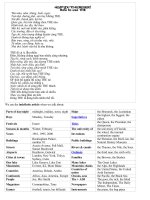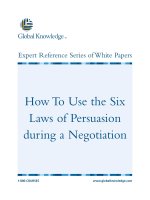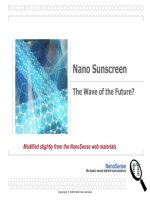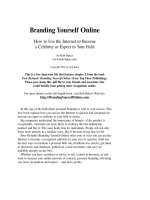Factors affecting passengers’ decisions to use the metropolitan rapid transit chalong ratchadham line (purple line)
Bạn đang xem bản rút gọn của tài liệu. Xem và tải ngay bản đầy đủ của tài liệu tại đây (194.02 KB, 13 trang )
Factors affecting Passengers’ Decisions to Use the
Metropolitan Rapid Transit Chalong Ratchadham Line
(Purple Line)
Krongthong Heebkhoksung
Bansomdejchaopraya Rajabhat University
Abstract
The objectives of this research were to study factors affecting passengers’ decisions to use the
Metropolitan
Rapid Transit Chalong Ratchadham Line (Purple Line) and to study whether passengers decided to
use MRT
Chalong Ratchadham Line. The setting of this study was area around MRT Chalong Ratchadham Line
(Purple
Line). Data were collected in March 2017. The aim of this research was to study predictor
factors and
passengers’ behaviors influencing the possibility of using Purple Line MRT. Mathematical
models could be
developed to predict the decision to use Purple Line MRT. The predictive results were used to
plan transport
management. Logistic Regression Analysis was used to determine the relationship. The results of
studying the
relationship showed that predictor factors influencing the possibility of using Purple Line MRT
included
available routes, fast, safe, and convenient transport as well as other factors. By comparing
Purple Line MRT
usage, the passengers’ decision to use this line was more than their decision not to use the
service.
Keywords: Metropolitan Rapid Transit Chalong Ratchadham Line, Purple Line
1. Introduction
The policy of decentralizing the prosperity to local administration areas has been formulated
by the government meanwhile number of population in the metropolitan area is still increasing.
The price of typical residences in Bangkok is expensive. Most people are unable to find a
residence in the city and are forced to live in the metropolitan area. However, most
employment sources are still located in Bangkok and are increasing. The greater number of
people living in outer areas needs for staying in Bangkok, resulting in traffic jam. Metropolitan
Rapid Transit system is important to facilitate the public transport without the usage of private
car. Presently, MRT structure is constructed in Bangkok and Metropolitan Area. The
Metropolitan Rapid Transit Chalong Ratchadham Line (Purple Line) contains total distance of 23
km. and 16 stations. The behaviors of using Purple Line MRT service were studied in this
research to analyze basic data and decision criteria to decide to use the Purple Line MRT
towards the development of a Binary Choice Model to predict the probability of passengers to
use the Purple Line MRT.
2. Objectives
1.To study the demographic characteristics affecting the decision to use Purple Line MRT
service.
2.To study behaviors of Purple Line passengers affecting possibility of using Purple Line MRT
service.
3. To develop a mathematical model for predicting the selection of using Purple Line MRT
service when factors and behaviors affecting passengers’ decision to use Purple Line MRT
service.
3.
Methodology
181
Data analysis in this research could be divided into 4 parts as follows:
Analysis of demographic data
Analysis of factors affecting the usage of Purple Line MRT
Analysis of behaviors of Purple Line MRT passengers
Analysis of data for hypothesis testing and summary.
- Hypothesis 1: The samples with different demographic characteristics emphasize on
factors affecting the decision to use Purple Line MRT.
- Hypothesis 2: Demographic characteristics of Purple Line MRT passengers affect the
decision to use or not use Purple Line MRT.
- Hypothesis 3: Factors affecting the decision to use or not use Purple Line MRT.
- Hypothesis 4: Behaviors of the Purple Line MRT passengers affect the decision to use or not
use Purple Line MRT.
4. Logistic Regression Analysis
Logistic regression analysis or Logit Analysis is the analysis of the predictive equation to
study the effect of a predictor variable on a dichotomous variable or polytomous variable.
Logistic Function represents the relationship between predictor variable and probability of the
occurrence of events according to the criterion variable (Sirichai Kanchanawasee. 2005: 39). In
conclusion, there are three concepts of regression analysis in case that dependent variables
are dichotomous variables (Sriridej Sucheewa: 1996: p. 17).
Conditional mean of regression equation shall be converted to be from 0 to 1, which
is suitable for logistic regression analysis.
The distribution of errors must be binomial, which will be the basic statistical
distribution for further analysis.
Other principles of linear regression analysis can be applied to logistic regression.
If Chi-square is significant, it means that an independent variable or a set of
independent variables is related to the dependent variable.
If -2 Log Likelihood is close to 0, it means that the model has higher goodness-of-fit
than other models (if its value is 0, it is the perfect model.)
The significance of each independent variable in the model was validated with Wald statistic
( t-statistics were used in Linear Regression). The model’s ability to forecast is considered by %
of Classification. When the goodness-of-fit was validated, the next steps are the analysis and
determination of statistics from the analysis.
The relationship between a set of independent variables and dependent variable was
tested by -2 log Likelihood and Chi-square statistics.
The model’s Goodness of fit was tested with Chi-square statistics.
The significance of each independent variable in the model was validated with Wald
statistic.
The model’s predictability was tested by considering % of Classification.
Studying the passengers’ decision to use or not use Purple Line MRT is useful to prepare or
manage to plan the implementation efficiently and effectively. The variables affecting the
decision to use the Purple Line MRT are classified into 3 groups as follows:
Variables related to passengers’ personal characteristics are gender, age and
occupation.
Variables related to the factors influencing the use of the Purple Line MRT including
Purple Line MRT service usage, fares, station location, marketing promotion,
employee service, service process, station facilities.
182
Variables related to the behavior of using the Purple Line MRT including weekly usage
frequency,
most frequently period of time to use the service, main objective of using the service,
reason to use the service, and reason not to use the service.
Some variables described above had positive impact(this implied that data collected from
the questionnaire were then analyzed through table and Logistic Regression Analysis.
5. Results
The results of data analysis showed that the samples were males(46.76%) and females
(53.24%). Most of the samples were those aged between 21-30 years (33.5%). Most of the
samples were employees (33.50%). To study demographic factors of the samples who have
used the Purple Line MRT service, 11-item questionnaire was used. To study factors affecting
the decision to use Purple Line MRT, 24-item questionnaire was used with 5-rating scale. If an
answer is “5” means “highest” level and “1” means “lowest” level. From evaluating factors
affecting the decision to use Purple Line MRT, data collected were then analyzed to determine
the mean and standard deviation as shown in Table 1.
Table 1: Mean and standard deviation of the samples classified with factors affecting the decision to use Purple Line
MRT service
Items
x
S.D.
Purple Line MRT provides fast service without waiting
long time.
3.93
0.737
Purple Line MRT provides sufficient number of trains to
meet the passengers’ need.
4.07
0.755
Purple Line MRT provides more convenient transport.
3.97
0.798
Purple Line MRT provides convenient transport of BTS or
MRT linkage.
3.79
0.886
Passenger fare is reasonable and based on distance.
3.72
0.808
Passenger fares are classified by passenger’s age. Children
and students are charged cheaper than general
passengers.
3.75
0.782
3.83
0.916
3.585
0.918
Routes are convenient.
3.76
0.887
Number of stations is enough.
3.78
0.856
Public relations are available through various media.
3.40
0.884
A list of fares is clearly displayed on ticketing machine
and
easily understood.
Station location is near major landmarks such as
office,
department store and educational institution.
Symbol
183
Items
x
S.D.
Discount is offered for top-up card.
3.59
0.753
Documents are distributed to educate routes.
3.44
0.978
MRT officers are polite and friendly.
3.73
0.965
Number of stationed officers in each station is enough to
meet the demand.
3.69
0.911
MRT officers pay their attention to clients and make them
feel impressive.
3.63
0.968
Steps of using MRT service are not complicated and
passengers can do self-service.
3.97
0.813
MRT service is punctual. Period of waiting for the
passengers is consistent.
3.93
0.723
Queuing is formed to access to the service.
3.82
0.921
MRT provide facilities for disable people such as
entranceexit,
toilet for priority, disable people, and Braille signs.
3.74
0.970
MRT station is clean and tidy.
3.74
0.870
Elevator, toilet, telephone box, ATM, and shops are
available.
3.23
0.995
Both Thai and English signage are available for the
passengers.
3.69
0.979
Ticket is issued easily.
3.67
0.966
Symbol
To study the behaviors of using the Purple Line MRT service, 15-item scale was used as
shown in table 2.
Table 2 : Number and percentage of the samples classified by behaviors of using Purple
Line MRT service
Items
Frequency Percentage Symbol
1 – 2 times/week
113
28.25
3 – 4 times/week
116
29
5 – 6 times/week
64
16
Over 6 times/week
107
26.75
05.30 – 09.30 hrs.
150
37.5
Items
Frequency Percentage Symbol
184
09.31 – 12.30 hrs.
53
13.25
12.31 – 15.30 hrs.
56
14
15.31 – 18.30 hrs.
85
21.25
18.31 – 22.40 hrs.
56
14
Routes available meet the passenger’s need.
183
45.75
MRT transport is convenient.
140
35
MRT transport is safe and convenient.
71
17.75
Station is not located in the area where a passenger
lives.
190
47.50
Number of co-users is large.
34
8.50
Expense is
high.
143
35.75
Table 3: Statistics of the model of Purple Line MRT
passengers
Omnibus Test
Chi-Square
136.457
Sig.
0.000*
Cox&Snell
R2
0.289
Nakelkerke
R2
0.507
Hosmer and Lemeshow Test
Chi-Square
8.233
Sig.
0.411
Initial -2 Log Likelihood : 338.167
-2LL of Full Model : 201.711
* Reject the hypothesis at a significance level of 0.05.
From Table 3, the Chi-square statistics was 136.457 (sig. = 0.000). This meant that at least
one factor influenced the decision to use Purple Line MRT with -2 log likelihood value
approaching zero. This implied that constructed equation or model had good quality or
consistency with data. Cox & Snell R Square value was 0.289 which was not close to zero. This
indicated the model’s consistency in terms of comparing the quality of the model created with
the worst model, a null model with no independent variable. The Nagelkerke R Square value
was 0.507. This meant that independent variables could explain 50.70% of the variation in the
service usage. When Wald Statistic of over 1 was considered and Sig. value was less than 0.05,
only variables as in Table 4 influenced predictive equation of Purple Line MRT usage.
185
Table 4: Variables affecting predictive equation of Purple Line MRT service
Variables
Number
of trains is
Variables
enough to
β
S.E.
0.857
0.320
β
S.E.
Wald
df
Sig.
Exp (β)
7.152
1
0.007*
2.356
Wald
df
Sig.
Exp (β)
meet the
1.892
passengers’ needs.
Convenient transport of
both BTS or MRT linkage.
Uncomplicated
steps of using the
service and selfservice
0.333
2.955
2.818
Usage frequency of
1 -2 times/week
Usage frequency of
3 -4 time/week
Period of using the
service during
12.31-15.30 hrs.
Constant
0.638
0.264
5.817
1 0.016*
0.153
-1.099
1.084
1.036
-1.876
16.633
0.309
0.489
0.431
0.834
46160.88
9
12.645
4.910
5.781
5.064
0.000
1
1
1
1
1
16734186.
077
0.000*
0.027*
0.016*
0.024*
1.000
Logistic Regression Equation was obtained as follows:
Table 4 shows that factors influencing the decision to use the Purple Line MRT were as
follows. Sufficient number of MRT trains influenced the increase in using Purple Line MRT
service by 2.356 times. Convenient transport of BTS or MRT linkage influenced the increase in
using Purple Line MRT service by 1.892 times. Uncomplicated service usage steps and
selfservice influenced the increase in using Purple Line MRT service by 0.333 times. Queuing of
passengers influenced the increase in using Purple Line MRT service by 2.660 times. The
service usage of 1-2 times /week influenced the increase in using Purple Line MRT service by
2.995 times. The service usage of 3-4 times /week influenced the increase in using Purple Line
MRT service by 2.818 times. The service usage during 12.31-15.30 hrs. influenced the increase
in using Purple Line MRT service by 0.153 times.
186
6. Discussions
Firstly, the service usage of 1-2 times /week influenced the increase in using Purple Line
MRT service by 2.995 times. This implied that number of passengers of Purple Line MRT was 92
and will be increased by 271 in the next five years because of available routes, fast, safe and
convenient transport.
Secondly, the service usage of 3-4 times /week influenced the increase in using Purple Line
MRT service by 2.818 times. This implied that number of passengers of Purple Line MRT was 94
and will be increased by 264 in the next five years because of available routes, fast, safe and
convenient transport.
Thirdly, queuing of passengers influenced the increase in using Purple Line MRT service by
2.660 times. This implied that number of passengers of Purple Line MRT was 340 and will be
increased by 904 in the next five years because of available routes, fast, safe and convenient
transport.
Fourthly, sufficient number of MRT trains influenced the increase in using Purple Line MRT
service by 2.356 times. This implied that number of passengers of Purple Line MRT was 340
and will be increased by 801 in the next five years because of available routes, fast, safe and
convenient transport.
Fifthly, convenient transport of BTS or MRT linkage influenced the increase in using Purple
Line MRT service by 1.892 times. This implied that number of passengers of Purple Line MRT
was 340 and will be increased by 643 in the next five years because of available routes, fast,
safe and convenient transport.
Sixthly, uncomplicated service usage steps and self-service influenced the increase in using
Purple Line MRT service by 0.333 times. This implied that number of passengers of Purple Line
MRT was 340 and will be increased by in the next five years because of available routes, fast,
safe and convenient transport.
Seventhly, the service usage during 12.31-15.30 hrs. influenced the increase in using Purple
Line MRT service by 0.153 times. . This implied that number of passengers of Purple Line MRT
was 53 and will be increased by 8 in next five years 5 because of available routes, fast, safe
and convenient transport.
7. Suggestions
More questionnaire examples should be prepared as greater information leads to lower
errors. This also provides benefits to make Purple Line MRT service improvement plan.
The study period was from 08.00-18.00 hrs. from Monday to Friday. Therefore, other periods
of time should be explored to increase data. Additional survey should be conducted during
Saturdays and Sundays for data coverage.
Convenient access to sky train stations should be studied.
-Greater studies on public needs for station locations should be conducted.
-More studies should be conducted to investigate whether the public accepts fare or not.
References
Kamol Tharuarak. ( 2005). Simulation Model of Route Selection Behaviors with Binary Logit Model (Revealed
Preference). Report of Bureau of Road Research and Development.
Kietiphong Jearanuntanakij. ( 2006). Simulation Model of Route Selection Behaviors with Multinomial Logit Model (The
Case Study of Bangkok-Pattaya Route). Bureau of Road Research and Development.
Chalita Padungmit. ( 2009). Factors Affecting the Selection of Bangkok- Chiang Mai Routes. International Business
Administration, Logistics & Transport, Thammasat University
Napat Lekawatthana. ( 2013). Developing the Model of Selection of Transport for Students Between School Bus and
Other Vehicles.
Faculty of Transport engineering, Suranaree University of Technology.
Tawinan Simajaruk. (2013). Cost Reduction in Transport: The Case Study of Chemical Plant, Faculty of Logistics,
Burapha University.
Narucha Chaodee. (2005). Opinions towards the Service of State Railway of Thailand: The Case Study of the East Line.
(Bangkok - Aranyaprathet). Burapha University.
Paweena Khampukka. (2016). The Willingness of Students and Personnel to Pay for Public Van for Ubon Ratchathani
University-Ubon Ratchathani Bus Terminal. Academic Journal:
Far Eastern University.
Piti Jantruthai. (2016). Factors Influencing the Decision to Select Public System in the City Area. Academic Journal:
Princess of Naradhiwas University.
187
Pachara Jitchang. (2010). The Study of Decision to Use MRT of People In Bangkok. General Business Management.
Silpakorn University.
Bhawat Chaichannawatik. (2013). Long Distance Travel Behaviors of Bangkok Residents: The Study of Selecting
Transport Model.
Academic Journal. Kasem Bundit University)
Yuth Kaiyawan. ( 2012). Principles and Applications of Logistic Regression Analysis for Research. Research Journal:
Rajamangala University of Technology Srivijaya.
Weerayuth Wattanatham. (2012). Factors Influencing the Decision of Passengers to Select the Railway Transport Service of
Suvarnabhumi Airport and the Airport Terminal in the City. Department of Civil Engineering. Faculty of Engineering.
Kasetsart University.
Sirichai Karnchanawasee. ( 2005). Multi-level Analysis. Bangkok: 3 rd Edition. Chulalongkorn University Press.
Siridej Sujiva. ( 1996, January - June) . Logistics Logistic Analysis: Concept, Analysis, and Interpretation Research
Methodology. 8 (1): 10-34.
Atcharaphorn Jirachartphong. (2013). Using Railway Transport Service of Suvarnabhumi Airport and the Airport Terminal
in the City in Passengers’ Perspective. Department of
Marketing Management. Faculty of Business Administration. Dhurakij Pundit University.
188









